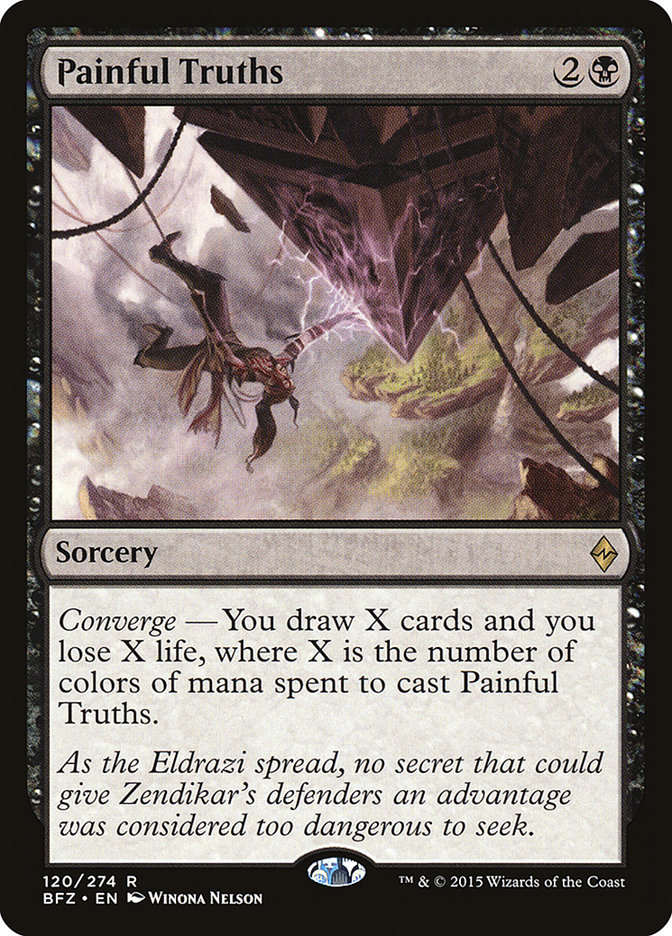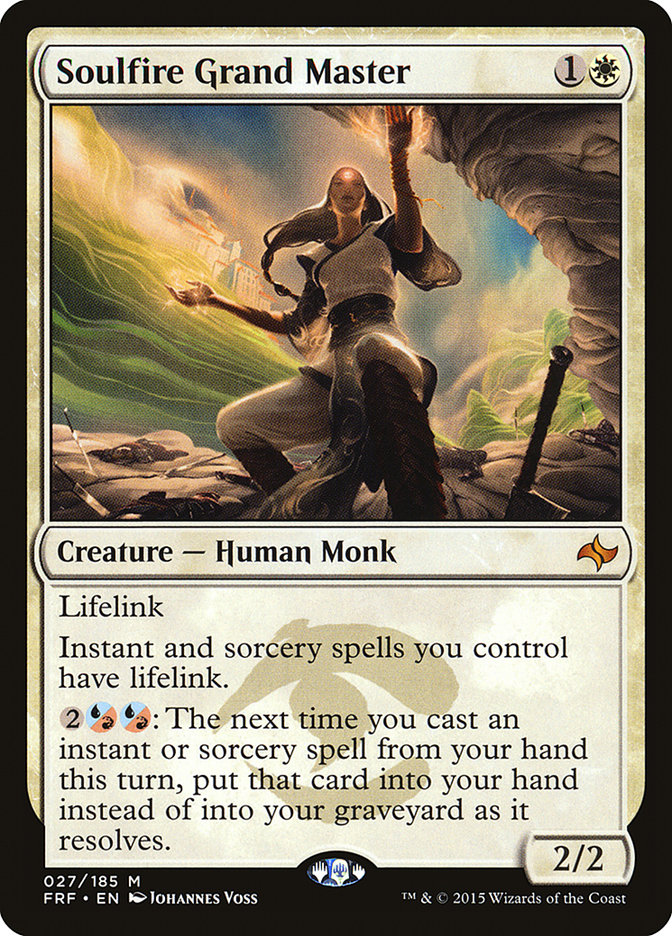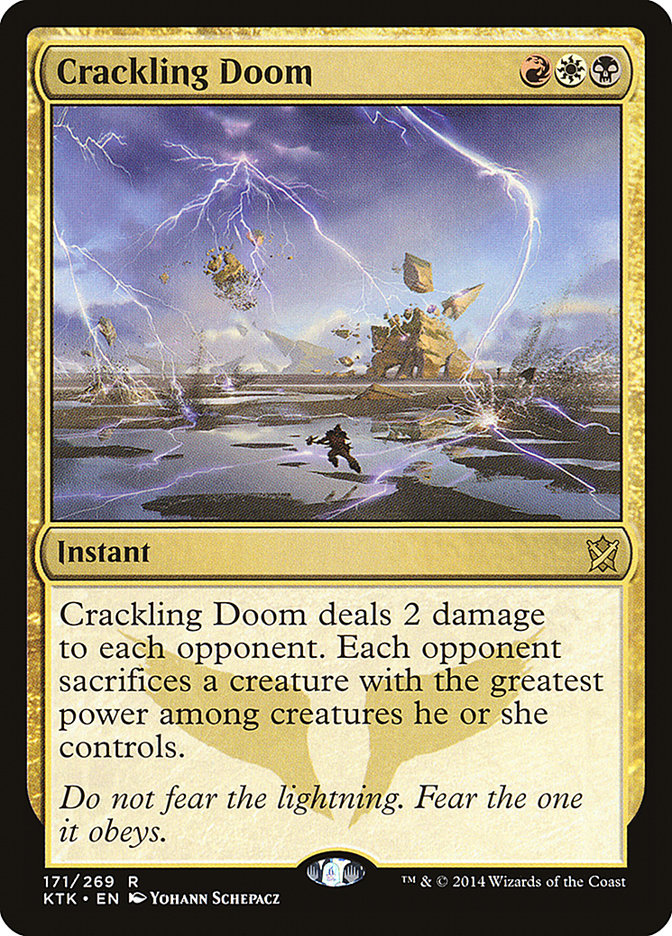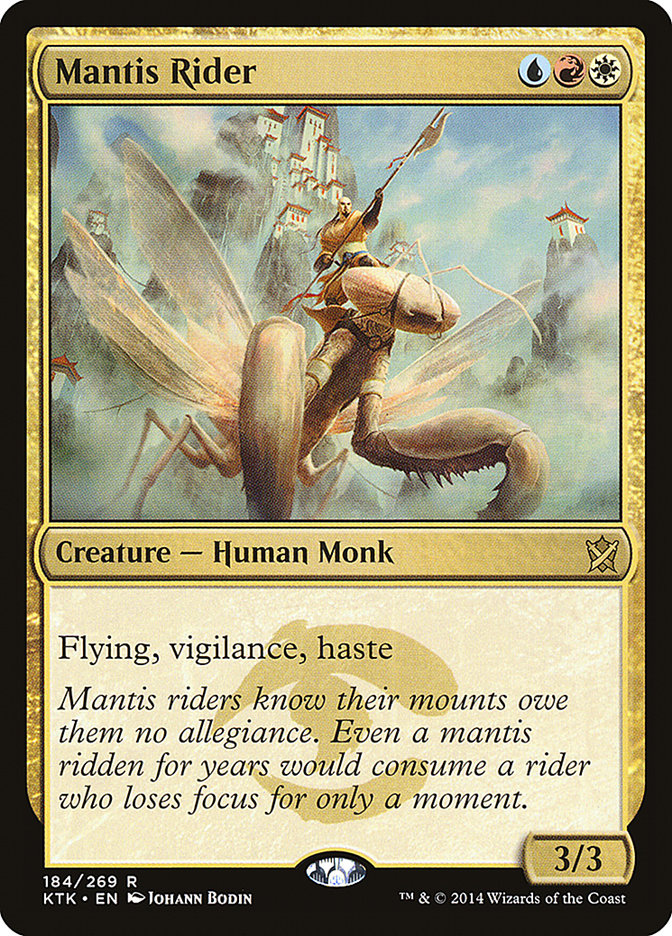I’m definitely someone who approaches Magic in a specific way. It might look like I’m brute forcing the format at times, but in practice, it’s much more
methodical than that.
I figure out the rules. What constrains the format, what key points you have to hit to beat decks, and in turn, what is missing.
As the metagame sets up to revolve around Jeskai Black in the wake of last weekend’s Grand Prix, these are the underlying principles that drive it that
direction.
Mana
More than anything else, this is what runs current Standard. There’s a laundry list of powerful cards, and it’s mostly a matter of figuring out which ones
can actually be put into the same deck without compromising its consistency.
In this specific format, where you have absurdly powerful aggressive options like Mantis Rider, Anafenza, the Foremost, and Siege Rhino, that consistency
is both having your colors and having your plays on curve, unlike last Standard where the good mana was tied to longer games and playing off curve with
Temples.
Let’s break down all the options:
Mono-Color:
The draw to more conservative manabases is one-drops. If you are leaning too hard on Battle lands to make your colors work, you are likely to have to cast
one on the first turn and miss your window for your aggro threat. Monastery Swiftspear is the big one that drives Atarka Red, but there is also the
possibility that Kytheon, Hero of Akros is worth a deck.
The problem from here is that the cost of splashing is fairly minimal. Look at how Atarka Red basically freerolls seven or eight green cards due to the
whole fetchland + Battle land mana giving it a ton of free sources.
Why wouldn’t you splash? Well, playing fetchlands costs you about 2-4 life a game, so if you expect aggro mirrors, it might be better to be the person
starting at twenty life instead of eighteen life. The other reason to not splash is to take advantage of non-basic spell lands like the Blighted cycle or
more powerful mana producing non-basics like Shine of the Forsaken Gods. You can play these cards in decks with more colors, but the quantities you can
play them in are limited. Compare Reid Duke playing two Mage-Ring Network and one Haven of the Spirit Dragon in a 27-land Esper deck last weekend at Grand
Prix Quebec City (he is basically cutting 1-2 spells to fit these) while Jake Mondello played four Sanctum of Ugin, four Shrine of the Forsaken Gods, a
Haven of the Spirit Dragon, and a Blighted Woodland in a 25-land near Mono-Green Eldrazi Ramp deck. Note that Jake still did splash red, but that was more
a feature of playing twelve sorcery-speed fixers as he opted for zero fetchlands.
Two Color:
Two color decks can also support one-drops, but are slightly less reliable at it. Atarka Red really needs to land its Zurgo Bellstriker on turn 1 for the
card to be effective. Warden of the First Tree in G/W Megamorpgh being cast a turn or two later isn’t the end of the world if you draw Flooded Strand,
Flooded Strand, Canopy Vista, and even in R/G Landfall casting Scythe Leopard on turn 2 is fine because a 3/3 is so big.
The choice in two-color decks is if you want to hit one-drops of both color or want a double colored spell early on. This is basically a typical “is my
mana reasonable” decision of not trying to curve Bloodsoaked Champion into Dragon Whisperer (which is actually impossible). Once you get to three or four
mana, things are a free for all, as evidenced by the Avatar of the Resolute > Deathmist Raptor > Gideon, Ally of Zendikar > Wingmate Roc curve by
G/W Megamorph, but you have to decide where you want to stand on your earlygame mana and make card decisions appropriately.
Similar to single color, the third color splash is easy. It’s even more free here, as two-color decks want to play fetchlands anyways, so you aren’t paying
extra life. You just have to accept that you will only have nine or so sources of the color and that it has to be one of the on-Shard allies of your pair.
For example, splashing black into G/W is a real commitment, but splashing red or blue is pretty easy. Since the splash is so light, it basically has to be
for small numbers of niche answers or high end threats and not anything you want on curve, but I don’t think G/W is unhappy to cast a Disdainful Stroke or
Dispel out of the sideboard. Or in the main if you’re Sam Black.
Three Colors:
Adding a third color really cuts into your ability to reliably cast one-drops. Kazuyuki Takimura won the Pro Tour with four Warden of the First Tree in an
Abzan deck, but as I was watching the top 8, there were many instances where Warden > level it > Anafenza was simply not possible with the set of
lands he drew. This is also true in decks playing Shard mana, as you are really leaning on drawing the right set of fetchlands in a very small time frame
to make it all curve out. As I stated above, playing Warden of the First Tree is fine because it’s so good at all phases of the game, but now you are
basically limited to one-drops of that caliber.
The next thing about playing three colors: there’s a huge difference between Shard and Wedge mana.
Shard mana is super easy. You just have to pick a color you aren’t going to have double of early. You could go wild and play Gideon, Ally of Zendikar,
Deathmist Raptor, and Thunderbreak Regent in the same deck, but there’s no way to cast all of those on time if you draw them together. Deathmist Raptor,
Thunderbreak Regent, and some Murderous Cuts though? That’s a breeze. These decks are typically playing 10-11 fetchlands, with eight of the double on-color
ones and 1-2 of each single on-color one. For example, the above Jund mana I tested that worked very well included four Bloodstained Mire, four Wooded
Foothills, two Windswept Heath, and one Polluted Delta.
Wedge mana is a bit more difficult. I would use what Kazayuki Takimura opted to play as a template for this moving forward, which is also notably the same
as the other Pro Tour finalist Ryoichi Tamada:
Creatures (21)
- 4 Anafenza, the Foremost
- 2 Wingmate Roc
- 4 Siege Rhino
- 4 Warden of the First Tree
- 4 Den Protector
- 3 Hangarback Walker
Planeswalkers (4)
Lands (26)
Spells (9)

Creatures (16)
Planeswalkers (4)
Lands (24)
Spells (16)

Choose two base colors. Max out on those fetchlands. Play the Battle lands that let you stretch the gap. If your base is the two allies, don’t play a basic
you can’t fetch. You can afford a handful of (or likely less) enters the battlefield tapped lands, which honestly should be creature-lands if possible.
Worth noting: In the “two enemies splash an ally” manabase, it’s super easy to splash the in between color. Tamada gets to play two green lands for free,
which unfortunately means nothing as there aren’t any good green cards. But he could play them if he really wanted!
This is where you also start to learn the limits on reasonable manabases. You can only play five, maybe six Battle lands before things really start to fall
apart. Honestly, the less you can get away with, the better because drawing one in your opening hand usually sucks.
In theory, there are other manabases that work here, but they kinda suck. The heavy non-fetch manabases are somewhere between super sketchy (two or so
sources short on each color) or super slow (six to eight tapped lands). You can try to hedge against the latter with cards like Languish, but as you will
see later, that is really hard to do against some of the real threats of the format. Just playing spells on time is better than anything we have available
this set, and unless the Oath of the Gatewatch creature-lands are pushed in power level, this likely remains the case.
Four Colors:
This is comically the norm as per Jeskai Black or Abzan Blue.
Pick two enemy colors. Choose the two allies in the middle that don’t make a Shard (i.e. W/R picks up U/B, U/G picks up B/R). Your ideal mana curve is
enemy basic one, enemy basic two, allied Battle land in the middle. Mountain, Fiery Impulse into Plains, Soulfire Grand Master into Sunken Hollow and
Mantis Rider or Crackling Doom. This is why curving out with Jace, Vryn’s Prodigy can get weird with Jeskai Black.
You can play double-colored spells here, but it requires increasing the number of tri-lands you play. This, in turn, really cuts into you curving out, as a
turn 1 Mystic Monastery also means your Battle lands are tapped for at least the next two turns. There is also going to be one color where you can’t play a
tri-land, and in turn, really can’t play double-colored spells at all. Just based on the tri-lands being wedges, this is going to be one of your allied
Battle land pair. Jeskai Black can play Dig Through Time or a double black spell, but certainly not both. The later would likely make people postings lists
call it Mardu Blue and make everyone scratch their heads, but whatever. The double-colored spells also should not be cards you want to play before turn 4.
Your first three turns fill out your colors, then you can start doubling down. Ruinous Path is a no go, but Pia and Kiran Nalaar is good.
Five Colors:
The old 3-3-3-3-3 fetch, singleton Battle lands and basics mana works as long as you don’t expect to play on curve. Mantis Rider into Siege Rhino is not a
real thing. You are accepting that you play behind curve at times in order to increase your absolute power level. The discrepancy isn’t quite Vivid land +
Reflecting Pool levels of speed for power trading, but it’s similar. I’m pretty sure you can play double-color spells of one color in this manabase, but I
haven’t done the work to figure out if you can play multiple colors of them reliably or really how many double-color spells you can cast. It’s probably
more than the “stock” one Languish, one Crux of Fate in the Bring to Light lists, but I’m pretty sure you can’t just jam Gideon, Ally of Zendikar into your
base-black removal deck with five colors of mana to hit by turn 5.
I really hope someone proves me wrong on that last one though, as that sounds straight up awesome.
There may also be some ability here to bleed something like Tamada’s manabase with a four-color deck, where incidentally your best setup involves you
having access to the Canopy Vista or similar that bridges the gap. You then get to splash some awesome sideboard card you were really missing, like Radiant
Flames off a Smoldering Marsh in an Abzan Blue deck. You aren’t trying to be a five-color deck, but you accidentally arrived at that point.
Lifegain
Mid-testing (aka pre-Crackling Doom in Jeskai Black everywhere) I had figured out the whole Shard mana thing and was pretty high on a Jund Dragons deck. It
had the whole Deathmist Raptor + Den Protector thing going for it in the lategame, Draconic Roar in the earlygame, and powerful Dragons like Thunderbreak
Regent and Dragonlord Kolaghan in the midgame. This was also the deck where I discovered that Painful Truths is actually a really good Magic card, mostly
because it let this deck keep up with Abzan in raw attrition.
And guess what? Sometimes you would play all your things, have them line up fairly well, and just die because you had no way of getting out of range of
anything. Between the 2-4 life off fetchlands, not being the fastest deck to get on board, and the various powerful chip shot damage sources of the format
like Mantis Rider and Siege Rhino, it was real easy to just be dead despite being ahead on all tangible resources. We saw the same thing a year ago with
the heavier painland manabases.
Abzan has Siege Rhino, Shambling Vent, and Sorin, Lord of Innistrad. Jeskai has Soulfire Grand Master, Ojutai’s Command, and Jeskai Charm. G/W has Warden
of the First Tree and Wingmate Roc. These are all powerful cards in their own right that give you a little extra cushion. Any way you look at it, your
games are much less likely to be pulled out from underneath you if you have something that lets you reestablish your life total after using it as a
resource.
This is probably less important now since it’s easier to know and use the right answers, which makes your final life buffer in the end game higher, but if
you are trying to build a non-white deck, be very aware that you have to close in a relatively quick window most of the time. Thankfully for the Temur
mages of the world, your cards are good at doing that. But if you want to be Junding, you have to be very conservative with cards like Ob Nixilis Reignited
to not fall into this trap.
Crackling Doom
Crackling Doom is this format’s Hero’s Downfall. Generic three mana removal that just kills everything. This time it’s even more oppressive to creatures,
as the bonus two damage means that trading at mana parity still kinda sucks.
Basically any deck that was focused on a big threat that cost more than three just crumbled to this card. Esper Dragons? Not a deck, have to kill them with
Ob Nixilis Reignited. Thunderbreak Regent? Nice triggered ability that does nothing. We had the four mana 4/4 flyer as our sideboard plan against Jeskai
out of R/G Landfall for a long time before we just got sick of it being just “okay” and dying all the time to Crackling Doom.
Most decks in the format are basically all threats that trade well for Crackling Doom. Lots of low end three-drops with haste like Mantis Rider,
planeswalkers, four or higher drops with enters-the-battlefield triggers that give value like Siege Rhino or Wingmate Roc. Admittedly this is just saying
you play creatures that are good against removal, but in this case, the removal spell is good enough for a deck to add an extra color for it, so you aren’t
really going to dodge its presence in the metagame.
One plan is to just jam a bunch of things that die to Crackling Doom but hit so hard that you don’t care about them. Brian Kibler entered the testing house
with a “Light Temur Dragons” list packing Savage Knuckleblade, Thunderbreak Regent, Woodland Wanderer, and Dragonlord Ojutai that was shockingly good
against Crackling Doom. Or more accurately, it was really good against Jeskai decks packing Crackling Doom because they would eventually just run out of
Dooms and die as long as you kept Jace, Vryn’s Prodigy from flipping.
When on this overload plan, things also get better when your creature sizing is fairly flat and gives you the choice on what gets Edicted. Notice how
Anafenza, the Foremost as your three-drop lets you sacrifice your three mana legend instead of your four mana Siege Rhino and quickly brings Hangarback
Walkers to the point where it actually blanks Crackling Doom. Savage Knuckleblade is really nice here as it can scale up to protect larger threats like
Dragonlord Ojutai and Dragonlord Dromoka when you are fully on board, haste in for four damage if your opponent taps out to make the trade profitable, or
just bounce dodge removal if you get into a lategame grind fest.
If only Temur was actually capable of destroying an opposing permanent, we might have a real deck for it!
Gideon, Ally of Zendikar
We had a really awesome Enchantress deck in our Pro Tour Battle for Zendikar testing. It was basically a G/W Control deck and ran heavy on the
enchantment-based removal like Stasis Snare and Silkwrap. Herald on the Pantheon was easily the most powerful mana creature in the format while Mastery of
the Unseen and Sigil of the Empty Throne represented an absurdly hard to trump end game. The deck demolished Jeskai as it pulled out of range really
fast… and failed horribly against G/W Megamorph. More specifically, it just sucked against Gideon, Ally of Zendikar.
There’s a reason that Gideon was such a huge player in the Pro Tour Top 8. The card just ends games. It can be fragile, as four loyalty plus a 2/2 is
relatively easy to break through, but if you untap with it, the card finishes the game almost immediately.
The big thing is beating a Gideon on the draw. When you’re on the play, having a Siege Rhino or your own Gideon to win the fight is really easy. On the
draw you are suddenly trying to attack their Gideon with your three-drop, which is much harder when there’s at least a 2/2 in the way. This is a big part
of why Mantis Rider is so exceptional, as it does this job so well. This is also why Avatar of the Resolute was our mirror match trump, as a Dromoka’s Command pushing it
to a 4/3 trample and clearing the Knight was a straight up answer to the four loyalty Gideon left over.
Worth noting: It’s this card more than Crackling Doom suppressing the ramp decks. Both Dragonlord Atarka and Ulamog, the Ceaseless Hunger get value against
removal, but the ramp in this format isn’t actually good enough to stop you from dying to a virtual seven power four-drop.
Jace, Vryn’s Prodigy and Mantis Rider
Both of these cards are very good and very punishing if you don’t answer them. If your deck isn’t into playing creatures that die to recast removal, you
can ignore Jace for a bit, as there aren’t a ton of good value spells to Flashback and you won’t get Snapcaster Mage + Serum Visions two-for-one’d to
oblivion, but no one can ignore a Mantis Rider. Even taking the first hit is pretty bad, and there aren’t a lot of ways to prevent that from happening.
More so than anything else, these cards are homogenizing the metagame. Every deck has to devote 4-6 slots to answer these cards. There are some linear
strategies like Eldrazi Ramp and R/G Landfall that can kind of stand up to these cards on raw power, but at best it’s a hard maybe most games. If you start
diluting your deck with answers, you quickly realize it’s just better to be playing a deck that wants to play those answers if you need them than a linear
deck that is drawing off-plan cards that trade.
High Power
As mentioned at the start, there are an absurdly high number of good cards in this format. Battle for Zendikar only looks weaker because it is being
stacked up against a tri-color set. When every card is boosted in power because it’s harder to cast, then the barriers to casting them are removed, things
get this way. It’s not just the multicolored cards in Khans of Tarkir either, as you have prowess and delve pushed to Constructed levels. Fate Reforged and Dragons of Tarkir are on a similar level.
Unlike previous instances of this, like Bloodbraid Elf versus the rest of Shards of Alara block, the difference is that we have a balance here.
There are some cards that are definitely better, but they aren’t miles ahead of the rest. There are a huge number of cards competing at the same elevated
power level for space.
That’s where these rules help. Maybe there’s a great card that needs a deck. This is how you build a shell that can compete in the format that uses the
card. Or maybe that card is a trap because it lines up suboptimally against Crackling Doom.
I really suspect we have only scratched the surface of what is possible in this Standard format. When, and not if, someone dethrones Jeskai Black, expect
the floodgates to open.







